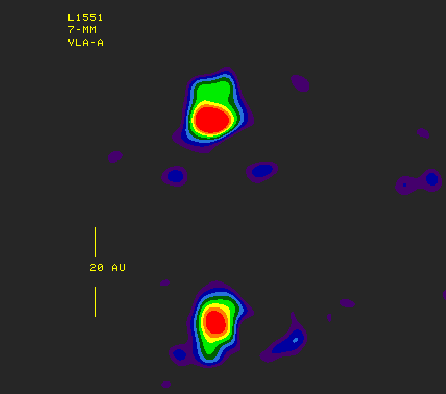Explanation: Sun-like stars are forming - and probably planets too - hidden inside Lynds 1551, an interstellar cloud of molecular gas and dust in the constellation Taurus. Using new receivers, coordinated radio telescopes at the Very Large Array near Socorro, New Mexico, USA, can now sharply image the dusty proto-planetary disks surrounding these young stars at radio wavelengths. Just announced, this exciting example shows a false-color radio picture of twin disks in a double star system! A yellow bar indicates the scale in astronomical units (AUs) where one AU is the average distance between the Earth and Sun. The stars (unseen near the center of each disk) are about 45 AUs apart, comparable to the radius of the orbit of Pluto. Similar proto-planetary disks have been seen around single stars, but these twin disks are much smaller, each limited in size by the gravity of the nearby companion star. In fact, if large planets form orbiting near the edges of these disks they may be ejected from the binary system.
1999 2000 2001 2002 2003 2004 2005 2006 2007 2008 2009 2010 2011 2012 2013 2014 2015 2016 2017 2018 2019 2020 2021 2022 2023 2024 2025 |
Yanvar' Fevral' Mart Aprel' Mai Iyun' Iyul' Avgust Sentyabr' Oktyabr' Noyabr' Dekabr' |
NASA Web Site Statements, Warnings, and Disclaimers
NASA Official: Jay Norris. Specific rights apply.
A service of: LHEA at NASA / GSFC
& Michigan Tech. U.
|
Publikacii s klyuchevymi slovami:
protoplanetary disk - binary star - dvoinye zvezdy - Protoplanetnye diski - Radiointerferometr
Publikacii so slovami: protoplanetary disk - binary star - dvoinye zvezdy - Protoplanetnye diski - Radiointerferometr | |
Sm. takzhe:
Vse publikacii na tu zhe temu >> | |
